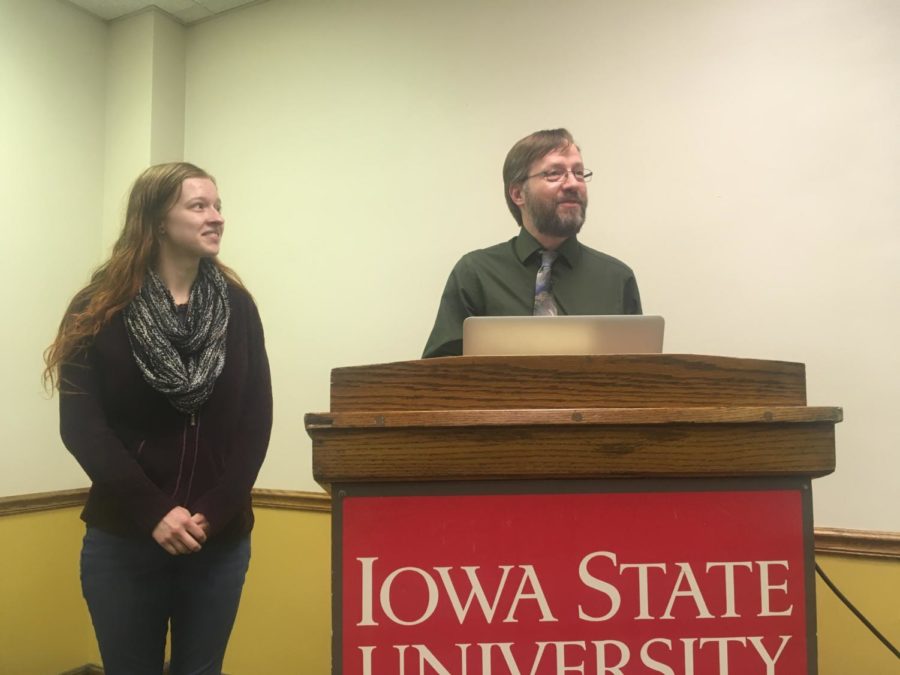‘Gender and Academia’ at Transforming Gender and Society 2018
David Wahl and Karah Lyons present during the Transforming Gender and Society Conference
April 7, 2018
Gender Equity in architecture
“Picture a ballerina. Now picture a construction worker.”
Greta Norris used a thought exercise to address gender stereotypes in professions.
Nationally, the ratio of women and men graduates in architecture is essentially equal, yet, at a ratio of 3:2, men graduate more with degrees in architecture at Iowa State.
There are competitions in Iowa and elsewhere that offer architecture students opportunities for scholarships, internships and even employment. Instructors at Iowa State are responsible for selecting students to advance to the competitions.
Twenty percent of those selected were women, while 34 percent of the 2018 class are women. Eighty-four percent of architecture instructors are men, according to the presenters. Seventy percent of the judges selected for these competitions were men.
Fewer than one in five award winners were women since 2010, according to research conducted by the presenters.
Anna Bednarko said the students presenting were part of a new wave of women architects challenging the mold.
Presenters said they were requesting immediate action to address gender disparities in hiring and representation in competitions.
Gender Dynamics in Academic Disciplines
Do female students who major in STEM feel marginalized? Do they perceive inequality in resources? Do male students in predominantly female academic disciplines feel the same? Do perceptions of inequality or marginalization factor in on undergraduates from applying for graduate school?
These questions are being asked by a research project in its infancy at Iowa State. Sociology Professor David Wahl, along with students Karah Lyons and Ally Mauer are conducting the study, asking DMACC and Iowa State students about their experiences.
Female students majoring in STEM have reported feeling marginalized in their field, as well as ignored in group work. They also report being ignored by professors.
“The patterns we have found through our literature review have continued over 40 years, through now,” Lyons said in reference to female students feeling marginalized.
Women are often given secretarial responsibilities in group work and Lyons said the marginalization of women students is often exacerbated in group work.
Male students majoring in predominantly female disciplines have also reported feeling marginalized. They felt they needed to subvert the female majority and often used hegemonic masculinity in an effort to do so. Wahl offered an example found in their literature review of male nurses who would chant “nursing, do it like a man.”
Plans are in the works to conduct in-person interviews and continue the study.
Is the Personal Pedagogical? Understanding the experiences of LGBTQ educators
In a literature review studying the experiences of LGBTQIA+ educators being conducted by Paul Hengesteg, LGBTQIA+ educators face an atmosphere of fear.
“Queer identities are often overlooked in those initiatives,” Hengesteg said in reference to diversity initiatives.
Hengesteg referred to his literary springboard as studying educators of color including a scholarly article conducted by Lori D. Patton and Christopher Catching titled “Teaching While Black.”
Hengesteg wants to answer the questions “Does being LGBTQ impact the classroom experience of educators?” and “How do experiences of LGBTQIA+ educators compare and contrast between K-12 and higher education?”
Hengesteg said his theoretical frames were articles by Adrienne Rich “Compulsory Heterosexuality” (1980) and by Judith Butler “Personhood” (2004) that studied the plight of queer women.
LGBTQIA+ educators in the K-12 system face a climate of fear, Hengesteg said. Hengesteg presented research on how gay teachers feel scared while working as teachers. He also presented examples of teachers who have been fired or demoted once they are outed as queer instructors.
He referenced research by Tiffany E. Wright and Nancy J. Smith, which found that many LGBTQIA+ instructors often hear homophobic slurs from students and professors alike, with no support from fellow faculty members.
Hengesteg also presented information showing that language arts teachers in the K-12 range can be hesitant to teach LGBTQIA+ concerns and issues, both heterosexual professors and otherwise, for fear of backlash.
In 41 percent of syllabi, sexual orientation is excluded in MTE courses in K-12.
















